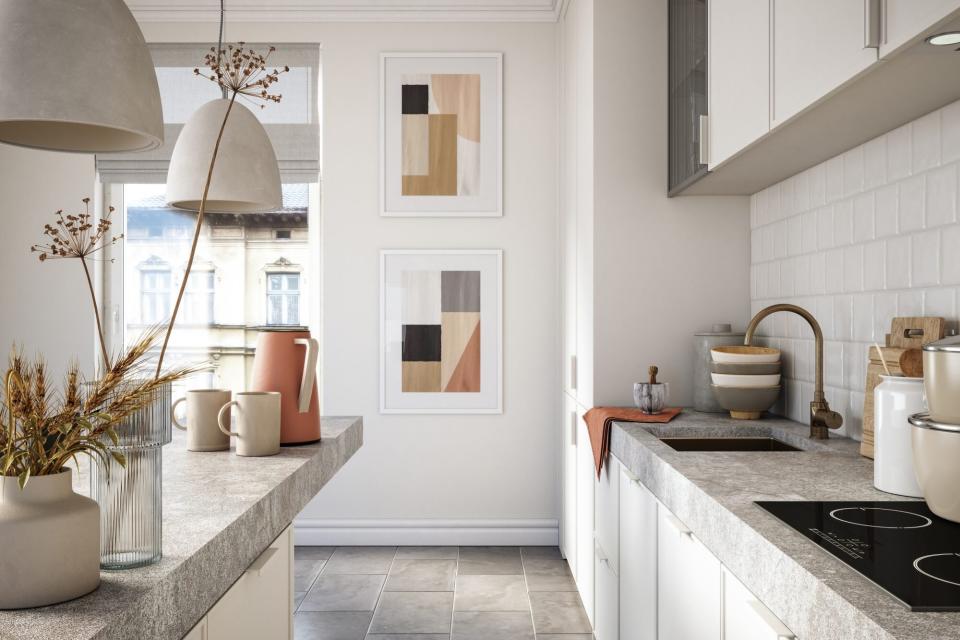Interior Designers Are Hanging Classical Art in the Kitchen: Here's What You Need to Know Before Trying This Trend

Andreas von Einsiedel / Getty Images
TABLE OF CONTENTS
On This Page
How to Choose Kitchen Art
Sourcing Tips
Placement and Hanging Tips
Art has always been—and always will be—a décor staple. It evokes emotion, lends balance, creates energy, and instantly personalizes a space. Art in the kitchen has been a trend through the years, too, but in recent months, there's been a notable shift. Tired of ultra-minimalist aesthetics and meticulous layouts, more people are embracing the drama that vintage-style oil paintings can lend a space. Think landscapes with swirling colors and austere portraits in ornate, gilded frames.
"The greater usage of oil paintings in the kitchen goes hand-in-hand with other trends we've been seeing regarding pretty interiors, softer lines, and cottagecore," notes Beth Diana Smith, an interior designer and brand ambassador for HomeGoods. "The attractiveness of this trend is easy to see. It softens the look of the kitchen, which usually contains harder materials—like cabinets, counters, and backsplashes—and gives a more romantic and European appeal."
Before trying this trend yourself, you'll want to keep a few things in mind regarding art selection and placement. We're covering everything you need to know ahead, including where to find affordable, one-of-a-kind vintage oil paintings for the heart of your home.
Related: 6 Kitchen Trends That Will Never Go Out of Style
How to Choose the Right Art for Your Kitchen
Consider Design Coherence
The first rule of sourcing art for your kitchen is to make sure it at least loosely aligns with the rest of your house. For example, perhaps the vintage piece pulls from your home's color scheme or the frame matches the finishes seen throughout the rest of the room.
Opt for the Unexpected
Avoid anything too literal, Smith explains. "I don't use traditional kitchen art, like images of fruit or food," she says. "The goal of a kitchen art piece that wows is to do the unexpected. Personally, I love portraits and abstracts for the kitchen because of the visual interest—and they make for a great topic of conversation."
Don't Splurge
Also keep cost in mind, notes Chelsey Brown, an interior designer and globally recognized heirloom hunter. She reminds us that the kitchen can be a messy place, so it's best to steer away from high-value, sentimental pieces that might get in the way of spaghetti sauce splatter or cooking-induced moisture.

GETTY IMAGES
Where to Source Affordable Kitchen Art
Flea Markets
Your local flea market is one of the best places to find affordable, one-of-a-kind oil paintings. It can be a bit of a treasure hunt, so go with an open mind and some extra time. "A good tip when negotiating at the flea market is to already have cash in your hand while you're stating a price," Brown says. "This makes it harder for a seller to turn down your offer."
Thrift Stores
While you may have more luck at the flea market, don't snooze on thrift stores. People consistently donate old gems they no longer have use for, and that may be the perfect piece for you. Go on a Monday morning after people have spent the weekend cleaning and dropping off their donations.
Etsy
Etsy sells both handcrafted goods and vintage finds, typically without the lofty price tags you'd expect at art galleries, notes Jessica Nelson, principal designer at Jessica Nelson Design. As a bonus, the search feature can make it easier to source exactly what you're looking for versus thrifting or poking around a flea market.
Online Marketplaces
You can also source gently used second hand art from websites such as eBay, OfferUp, and Facebook Marketplace. Again, the search function can make it easier to find a specific style, and many people are eager to sell, which makes for stellar steals.
Related: 4 Kitchen Trends That Need to Be Retired ASAP, According to Designers
How and Where to Place Art in Your Kitchen
From splashing water and oil splatter to open flames and food debris, kitchens are prone to a handful of potential art hazards. With that in mind, Smith recommends keeping your paintings at least 1 foot away from the sink and 2 feet away from the stovetop. This should help minimize any accidents and keep your art in good shape.
Hanging Tips
From there, Smith treats hanging art in the kitchen the same as any other room in the house. "I look at the line of sight at all entry points and any areas that I want to feel special," she says. "You can hang your piece slightly above a shelf, in an open upper area with no shelves or cabinets, or place an oversized piece on an empty wall for an unexpected touch."
Lean, Don't Hang
You don't necessarily need to hang your kitchen art, Brown notes. She recommends setting pieces on open shelves, hutches, free-standing cabinets, or even your countertop. To really lean into that cottagecore aesthetic, place the art alongside other vintage finds, such as antique wooden spoons, cutting boards, copper pans, cream-colored teapots, or dried floral arrangements.

